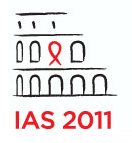Lersivirine: 48 week results compared to efavirenz in phase 2 treatment-naive study
1 August 2011. Related: Conference reports, Antiretrovirals, IAS 6th Rome 2011.
 Simon Collins, HIV i-Base
Simon Collins, HIV i-Base
Lersivirine is a once-daily NNRTI from ViiV that was originally developed by Pfizer and previously called UK-453061 and that is promising due to a resistance pathway at V108I that appears distinct from the K103N or Y181C pathways associated with first-generation non-nukes.
This double-blind, placebo-controlled study randomised 193 patients (1:1:1) to either 500 mg or 750 mg of lersivirine or to standard dose efavirenz, each with once-daily tenofovir/FTC. The primary endpoint was the percentage of patients with viral load reduced to <50 copies/mL at 48 weeks with follow up out to 96 weeks (by ITT missing = failure analysis).
Although enrollment criteria for the study included a CD4 count >200 cells/mm3, at baseline this ranged from 122 to 955 (median 310) suggesting that a few more advanced patients were included on an experimental combination than the European regulatory guidelines recommend for Phase II studies. Baseline viral loads ranged from 1,500 to 1,600,000 (mean: 50,000 copies/mL). Approximately 35% of patients had baseline viral load >100,000 copies/mL and this was reflected in pre-specified analysis of the results.
Other baseline characteristics included: mean age 36 years (range 21-62); 27% were women; race: 60% white, 30% black, 10% other. While the majority of people had sub-type B, ~30% of people were sub-type C which was reflected in ~ 30% enrolled in sites in South Africa.
At week 48, the percentage of patients with viral load <50 copies/mL was 79%, 79% and 86% in the 500 mg, 750 mg and efavirenz groups respectively. Although the study was not powered to detect a difference in efficacy between arms, the lersivirine arms suggested a poorer response compared to efavirenz (500 mg: 9% difference; 80%CI 18.1, 0.8 and 750 mg: 8% difference; 80%CI 17.0, 1.2).
Results stratified by baseline viral load (which was lower in the >100K group) or geographical region (which was lower for sites in South Africa) did not contradict this finding, see Table 1.
A mean CD4 count increased of approximately +190 cells/mm3 from baseline was similar between arms.
Virological failure occurred in 4, 5 and 3 patients in the 500 mg, 750 mg and efavirenz groups respectively, with people on lersivirine generally failing with M184V plus NNRTI mutations when resistance was isolated. The one person with identifiable mutations in the efavirenz arm failed with K103N alone.
Overall, the combined safety analysis reported a similar incidence of side effects in each group but fewer grade 3/4 events in the lersivirine groups (n= 2 and 3) compared to efavirenz (n=8) see Table 2. Laboratory abnormalities were infrequent and evenly distributed between arms. Lipids were broadly stable for lersivirine compared to increases in TC, LDL, HDL and TG for efavirenz, but this resulted in little difference between the LSV and EFV groups (+0.24 and -0.06 vs -0.3) in the change in the TC:HDL ratio used to evaluate cardiovascular risk.
However, the study concluded that both lersivirine doses showed similar efficacy to efavirenz over 48 weeks in treatment-naive patients and had different side effect profiles compared with efavirenz.
| LSV 500 mg | LSV 750 mg | EFV 600mg | |
|---|---|---|---|
| Primary endpoint % VL <50 | 79 | 79 | 86 |
| Baseline viral load <100K | 80 | 86 | 88 |
| Baseline viral load >100K | 75 | 62 | 82 |
| Region A* | 81 | 84 | 87 |
| South Africa | 72 | 68 | 83 |
| Region A* baseline viral load <100 K | 81 | 87 | 89 |
| Region A* baseline viral load >100 K | 81 | 77 | 85 |
* EU, Latin America, Australia, Canada
| N (%) | LSV 500 mg n=65 | LSV 750 mg n=55 | EFV 600 mg n=63 |
|---|---|---|---|
| Any AE: n (%) | 52 (80%) | 56 (86%) | 58 (92%) |
| Serious AE | 4 | 5 | 6 |
| Grade 3/4 | 4 | 9 | 14 |
| Discontinuation AE | 3 | 3 | 5 |
| Nausea (all grades) | 15 | 27 | 8 |
| Headache (all grades) | 15 | 11 | 9 |
| Abnormal dreams | 5 | 5 | 12 |
| Dizziness | 5 | 4 | 13 |
| Rash | 3 | 1 | 7 |
comment
There is still a role for new NNRTI with activity against nevirapine and efavirenz associated resistance with an improved safety profile to efavirenz.
The higher reports of nausea and headache appeared to be low grade but limited data was available on duration and severity of these events.
Reference
Pozniak A et al. Efficacy and safety of lersivirine (UK-453,061) vs. efavirenz in antiretroviral treatment-naive HIV-1-infected patients: week 48 primary analysis results from an ongoing, multicentre, randomised, double-blind, phase IIb trial (study A5271015). 6th IAS Conference on HIV Pathogenesis, Treatment and Prevention, 17-20 July 2011, Rome. Oral abstract TUAB0101. Webcast.

